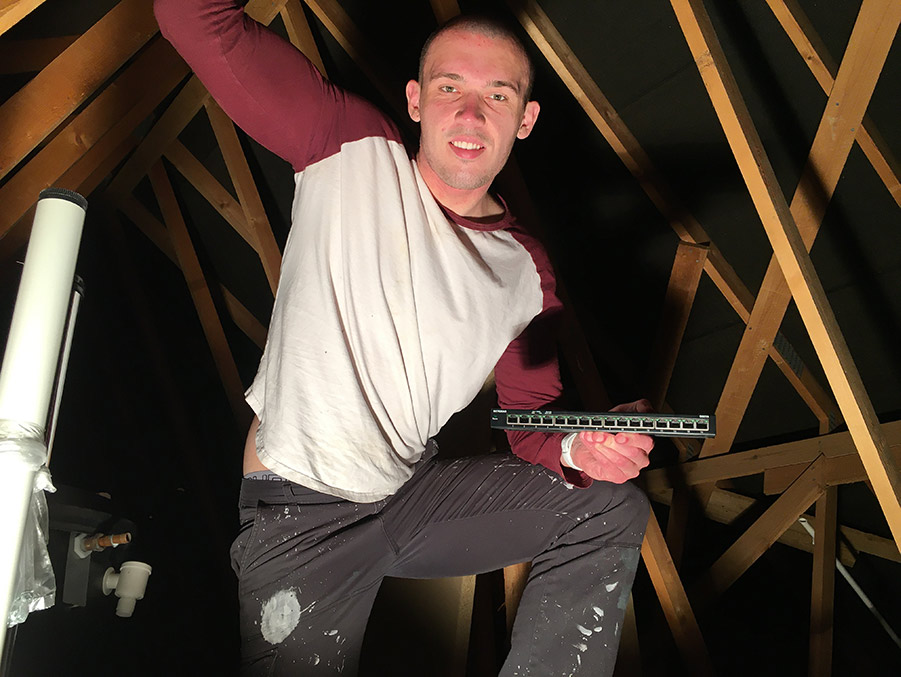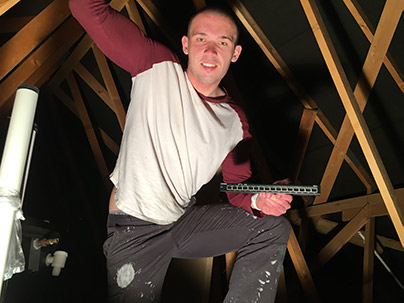Affiliate Disclosure: As an Amazon Associate I earn from qualifying purchases.
The loft can be seen as a convenient place to keep your network switch it is all out of the way and doesn’t need to be accessed very often. But that’s not to say it is for the best place for it.
Network switches can be placed in the loft, but the temperature in the loft and the operating temperature of the switch needs to be considered. Lofts can exceed 104°F which is also the average maximum operating temperature of a network switch. Placing it there can also reduce its lifespan.
I did some research into several different network switches to see whether they were suitable to placed within my own loft and whether there are other things to consider before you go ahead and place your network switch there.
Why You Shouldn’t Place a Network Switch in the Loft
The main reason for you not placing your network switch in your loft comes down to the loft generally being a hot and dusty environment.
Given that hot air rises, if there is going to be one area of your home that is the warmest, it’s going to be the loft.
And as you are probably already aware, a warm environment like that and networking equipment, or anything electrical for that matter, don’t tend to mix well.
You will also likely find that the lifespan of your switch decreases when it is placed in the loft.
Given that they typically remain powered on and working 24/7, you may find that you have to replace it sooner than you would like.
Now this isn’t so much of a concern if you only have a cheap unmanaged switch, but you probably want to consider it a bit more if you have a more expensive managed switch that has PoE ports and is the backbone for your entire home network.

How Hot Can a Loft Get?
This will vary depending primarily on where you live and your climate, but there in the UK, it’s not uncommon for a loft to exceed 104°F (40°C) during the particularly warm summer months.
As the sun shines directly onto the surface of the roof throughout the long days of summer, heat gets absorbed and is radiated into the loft space. If you don’t have adequate insulation in place, this temperature accumulated during the daytime can easily transfer into the roofs below your loft space too.
Other factors that can influence how hot a loft can get are how it is insulated, the airflow that exists and
The temperature in a loft is going to vary considerably from house to house depending on how it is insulated, the airflow, and the aspect of your home.
When you consider that a loft can exceed 104°F even here in the UK where we are known to receive particularly bad weather and generally not a lot of warmth, it’s another reason to consider finding somewhere else to place your network switch.
What Is the Operating Temperature of a Network Switch?
Just like how hot a loft can get depending on where you live, the operating temperature of your network switch will vary depending on the type of switch, the manufacturer, and the model.
A managed network switch that uses PoE (Power over Ethernet) will generally draw more power and as a result, generate more heat, than your standard unmanaged switch that just sits there as a way of providing additional Ethernet ports.
I did some research into a few different network switches of different types and from different manufacturers to find out what their operating temperature is which can help you decide whether or not they are suitable to be placed in a loft space.
| Network Switch | Operating Temperature |
| NETGEAR Nighthawk S8000 | 32°F – 104°F (0°C – 40°C) |
| NETGEAR GS810EMX | 32°F – 104°F (0°C – 40°C) |
| TP-Link TL-SG105 | 32°F – 104°F (0°C – 40°C) |
| TRENDnet TEG-S24DG | 32°F – 104°F (0°C – 40°C) |
| Ubiquiti UniFi | 23°F – 104°F (-5°C – 40°C) |
| NETGEAR GS316 | 32°F – 104°F (0°C – 40°C) |
| TP-Link T1500G | 32°F – 104°F (0°C – 40°C) |
As you can see, every switch other than the Ubiquiti Unifi has an operating temperature of 32°F – 104°F (0°C – 40°C). Even then, the Unifi switch can operate when it is a tiny bit colder, not hotter, so that is no good for us looking to place it in the loft.
Notice how the maximum temperature is right up there with the loft temperatures we can receive even here in the UK. I personally wouldn’t want to risk placing my switch up there when it is so close to the threshold.
Where Is the Best Place for a Network Switch?
My advice would be to avoid placing your switch in the loft wherever possible. Most people will have somewhere in their home where they can keep all of their networking equipment without it looking messy and having cables draped everywhere.
A cupboard is a great place to keep everything as it is easy to drill holes to run cables where they are needed and installing a shelf if you don’t already have one is also straightforward.
Everything will be out of sight unless the cupboard is open, yet still be easy to access should you need to.
I personally keep all of my networking gear, including my switch, in my garage.
It is much cooler in there so I never have to worry about anything overheating whilst it is also easy to access given that I can access the garage from the inside.
I live in a bungalow which was come in very helpful when running cables; I have them go up into the loft, along, and then down into whichever room I need them. If you have a home with multiple stories, this can be a bit more challenging.
The only problem I really face is when I want to run cables adjacent to all of my gear into my living room. Being a solid wall, drilling new holes can be tough work.
That being said, I have found the garage to be an excellent choice of place to keep all of my equipment, and I would recommend you do the same if you have the option.

What If You Have No Choice but to Use the Loft?
If you have no choice to place your network switch in the loft, which I doubt is the case for most people, you should at least take a few things into consideration.
Firstly, you need to remember that you need someway of providing power to your switch.
Running an extension lead up through the ceiling into the loft isn’t always practical and most lofts will not have power already installed. This means potentially having to get an electrician in to install some power outlets for you, which will inevitably cost you more money.
Also, consider whether any of your Ethernet cables need to be run outside in order to reach the switch in the loft. Most people will probably find they can just drill a small hole in the ceiling to run the cable, but if you do have to go outside, make sure you use external grade Ethernet cable.
The regular Ethernet cable you may already have is not designed to be used outdoors and could easily get damaged in the bad weather.
Even when using external grade Ethernet cable, it’s probably a good idea to still use some form of weatherproof conduit just to give the cable that extra layer of protection.
Finally, try and position the switch as close to the floor of the loft as you can, but without letting it get in contact with any of the loft insulation. Make sure it is raised up slightly on a plank of wood or something similar.
Although it may not make a huge difference, placing the switch lower down will help keep it that little bit cooler.
Final Thoughts
You could place your network switch in your loft and find that it continues to work absolutely fine, however, I personally wouldn’t want to risk it and would prefer to find somewhere else to keep it.
Even if the temperature in the loft is within the operating temperature of the switch, you also have the potential issue of dust getting in where it shouldn’t. Also, expect the lifespan of your switch to decrease.
If you have a cheap unmanaged switch, this may not be a concern for you, but for anyone with a more expensive managed switch that perhaps also has PoE ports, I would put a bit more consideration into where you position it.
If you found this article helpful, be sure to check out some of my other articles on network switches:
